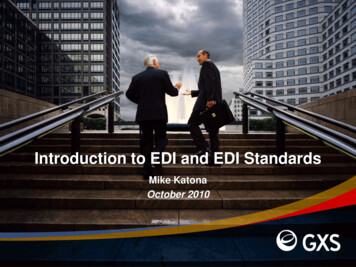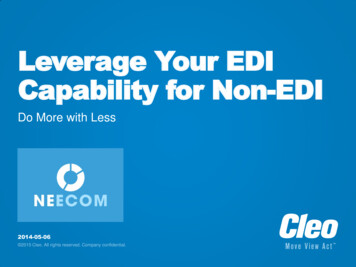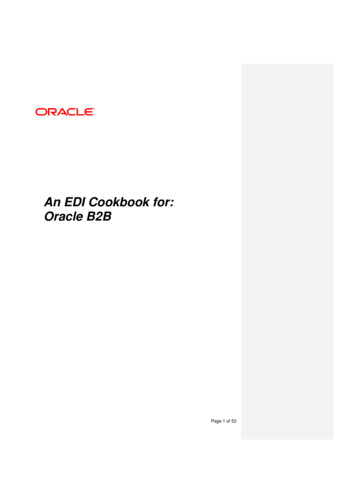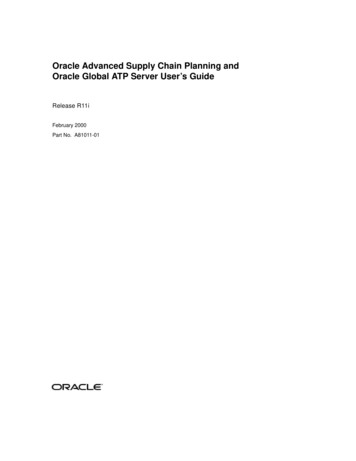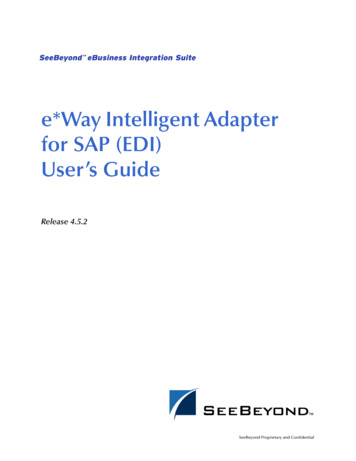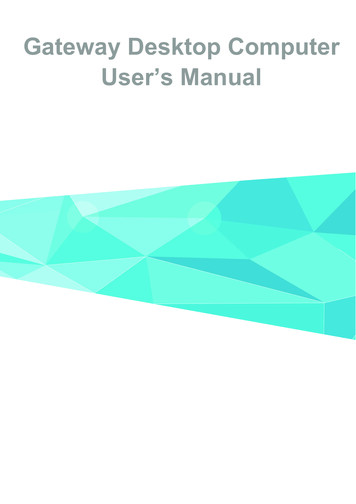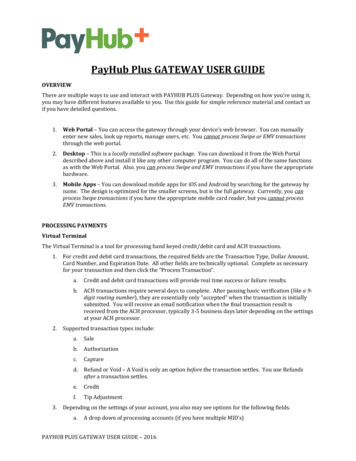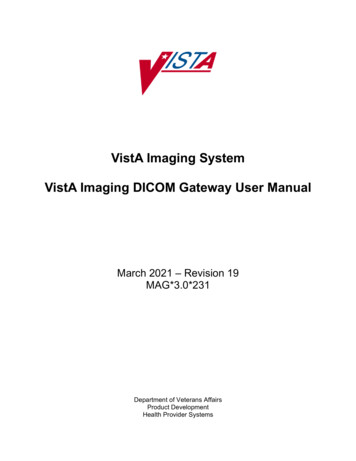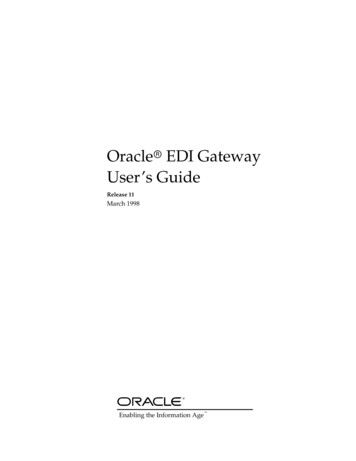
Transcription
Oracle EDI GatewayUser’s GuideRelease 11March 1998Enabling the Information Age
OracleR EDI Gateway User’s GuideRelease 11The part number for this volume is A58271–01.Copyright E 1998, Oracle Corporation. All Rights Reserved.Major Contributors: Kurt Thompson, Bonnie Williams, Janet LeeContributors: Garret Minakawa, David Wrightson, Winston LangThe programs (which include both the software and documentation) containproprietary information of Oracle Corporation; they are provided under a licenseagreement containing restrictions on use and disclosure and are also protected bycopyright, patent and other intellectual property law. Reverse engineering of thePrograms is prohibited.The information contained in this document is subject to change without notice. If youfind any problems in the documentation, please report them to us in writing. OracleCorporation does not warrant that this document is error–free. No part of this documentmay be reproduced or transmitted in any form or by any means, electronic or mechanical,for any purpose, without the express written permission of Oracle Corporation.Restricted Rights LegendPrograms delivered subject to the DOD FAR Supplement are ’commercial computersoftware’ and use, duplication and disclosure of the Programs shall be subject to thelicensing restrictions set forth in the applicable Oracle license agreement. Otherwise,Programs delivered subject to the Federal Acquisition Regulations are ’restrictedcomputer software’ and use, duplication and disclosure of the Programs shall be subject tothe restrictions in FAR 52.227–14, Rights in Data –– General, including Alternate III (June1987). Oracle Corporation, 500 Oracle Parkway, Redwood City, CA 94065.The Programs are not intended for use in any nuclear, aviation, mass transit, medical, orother inherently dangerous applications. It shall be licensee’s responsibility to take allappropriate fail–safe, back–up, redundancy and other measures to ensure the safe use ofsuch applications if the Programs are used for such purposes, and Oracle disclaimsliability for any damages caused by such use of the Programs.Oracle is a registered trademark and Oracle8, Oracle Application Object Library, OracleAlert, Oracle Financials, Oracle Quality, Oracle Workflow, Oracle Work in Process,SQL*Forms, SQL*Plus, SQL*AMX, SQL*Report, and SQL*ReportWriter are trademarks orregistered trademarks of Oracle Corporation.All other company or product names are mentioned for identification purposes only, andmay be trademarks of their respective owners.
ContentsPrefaceviiChapter 1Overview of Oracle EDI Gateway . . . . . . . . . . . . . . . . . . . . . . . . 1 – 1Overview of Oracle EDI Gateway . . . . . . . . . . . . . . . . . . . . . . . . . 1 – 2How To Use Oracle EDI Gateway . . . . . . . . . . . . . . . . . . . . . . 1 – 9Chapter 2Trading Partner Setup . . . . . . . . . . . . . . . . . . . . . . . . . . . . . . . . . . . 2 – 1Overview of Trading Partners . . . . . . . . . . . . . . . . . . . . . . . . . . . . . 2 – 2Defining Trading Partner Data . . . . . . . . . . . . . . . . . . . . . . . . 2 – 9Chapter 3Code Conversion . . . . . . . . . . . . . . . . . . . . . . . . . . . . . . . . . . . . . . .Overview of Code Conversion . . . . . . . . . . . . . . . . . . . . . . . . . . . .Defining Code Conversion Categories . . . . . . . . . . . . . . . . . .Assigning Categories . . . . . . . . . . . . . . . . . . . . . . . . . . . . . . . . .Predefined Code Categories . . . . . . . . . . . . . . . . . . . . . . . . . . .Defining Code Conversion Values . . . . . . . . . . . . . . . . . . . . .3–13–23 – 133 – 143 – 153 – 18Chapter 4Data File Structure . . . . . . . . . . . . . . . . . . . . . . . . . . . . . . . . . . . . . .Overview of Data File Structure . . . . . . . . . . . . . . . . . . . . . . . . . . .Control Record Layout . . . . . . . . . . . . . . . . . . . . . . . . . . . . . . .Required Inbound Control Record . . . . . . . . . . . . . . . . . . . . .Record Key (1–100) . . . . . . . . . . . . . . . . . . . . . . . . . . . . . . . . . .44444–1–2–4– 10– 11Contentsiii
Record Layout Codes Summary . . . . . . . . . . . . . . . . . . . . . . . 4 – 16Reusable Record Layout Details . . . . . . . . . . . . . . . . . . . . . . . 4 – 19Mapping Rules for EDI Translators . . . . . . . . . . . . . . . . . . . . 4 – 25Chapter 5Data File Definition . . . . . . . . . . . . . . . . . . . . . . . . . . . . . . . . . . . . . 5 – 1Changing the Data File . . . . . . . . . . . . . . . . . . . . . . . . . . . . . . . . . . . 5 – 2Chapter 6Importing and Extracting EDI Documents . . . . . . . . . . . . . . . . .Defining Data File Directories . . . . . . . . . . . . . . . . . . . . . . . . . . . . .Oracle EDI Gateway Profile Options . . . . . . . . . . . . . . . . . . . . . . .Running the Import Program for Inbound Transactions . . . . . .Running the Extract Programs for Outbound Transactions . . . .Viewing the Status of Concurrent Programs . . . . . . . . . . . . . . . .Data File Definition Format Legend . . . . . . . . . . . . . . . . . . . . . . .Chapter 7Inbound Transactions . . . . . . . . . . . . . . . . . . . . . . . . . . . . . . . . . . . 7 – 1Inbound Invoice (810 / INVOIC) . . . . . . . . . . . . . . . . . . . . . . . . . . 7 – 2Running the EDI Invoice Inbound Program . . . . . . . . . . . . . 7 – 3Inbound Price / Sales Catalog (832 / PRICAT) . . . . . . . . . . . . . . 7 – 6Running the EDI Price / Sales Catalog Inbound Program . 7 – 7Inbound Response to Request for Quote (843 / QUOTES) . . . . 7 – 10Running the EDI Response to Request forQuote Inbound Program . . . . . . . . . . . . . . . . . . . . . . . . . . . . . . 7 – 11Inbound Price / Sales Catalog and Response to Request forQuote Data File Organization . . . . . . . . . . . . . . . . . . . . . . . . . 7 – 14Inbound Purchase Order (850 / ORDERS) . . . . . . . . . . . . . . . . . . 7 – 19Running the EDI Purchase Order Inbound Program . . . . . . 7 – 20Inbound Purchase Order Data File Organization . . . . . . . . . 7 – 22Inbound Ship Notice / Manifest (856 / DESADV) . . . . . . . . . . . 7 – 27Running the EDI Ship Notice / Manifest Inbound Program 7 – 28Inbound Shipping and Billing Notice (857) . . . . . . . . . . . . . . . . . . 7 – 30Running the EDI Shipping and Billing Notice InboundProgram . . . . . . . . . . . . . . . . . . . . . . . . . . . . . . . . . . . . . . . . . . . . 7 – 31Inbound Ship Notice / Manifest and Shipping andBilling Notice Data File Organization . . . . . . . . . . . . . . . . . . . 7 – 33Chapter 8Outbound Transactions . . . . . . . . . . . . . . . . . . . . . . . . . . . . . . . . . 8 – 1Outbound Application Advice (824 / APERAK) . . . . . . . . . . . . 8 – 2iv Oracle EDI Gateway User’s Guide6–16–26–36–46–66–86–9
Running the EDI Application Advice OutboundExtract Program . . . . . . . . . . . . . . . . . . . . . . . . . . . . . . . . . . . . .Outbound Application Advice Data File Organization . . . .Outbound Invoice (810 / INVOIC) . . . . . . . . . . . . . . . . . . . . . . . .Running the EDI Invoice Outbound Extract Program . . . . .Outbound Invoice Data File Organization . . . . . . . . . . . . . . .Outbound Payment Order / Remittance Advice(820 / PAYORD, REMADV) . . . . . . . . . . . . . . . . . . . . . . . . . . . . . .Running the EDI Payment Order / Remittance AdviceOutbound Extract Program . . . . . . . . . . . . . . . . . . . . . . . . . . .Outbound Payment Order / Remittance Advice DataFile Organization . . . . . . . . . . . . . . . . . . . . . . . . . . . . . . . . . . . .Outbound Planning Schedule (830 / DELFOR) . . . . . . . . . . . . . .Outbound Planning Schedule Data File Organization . . . . .Outbound Shipping Schedule (862 / DELJIT) . . . . . . . . . . . . . . .Outbound Shipping Schedule Data File Organization . . . . .Running the EDI Outbound Planning and ShippingSchedule Extract Program . . . . . . . . . . . . . . . . . . . . . . . . . . . .Outbound Planning Schedule and Shipping ScheduleSummary Tables . . . . . . . . . . . . . . . . . . . . . . . . . . . . . . . . . . . . . . . .Outbound Purchase Order (850 / ORDERS) . . . . . . . . . . . . . . . .Running the EDI Purchase Order Outbound ExtractProgram . . . . . . . . . . . . . . . . . . . . . . . . . . . . . . . . . . . . . . . . . . . .Outbound Purchase Order Data File Organization . . . . . . .Outbound Purchase Order Change Request (860 / ORDCHG)Running the EDI Outbound Purchase Order ChangeRequest . . . . . . . . . . . . . . . . . . . . . . . . . . . . . . . . . . . . . . . . . . . .Outbound Purchase Order Change Request Data FileOrganization . . . . . . . . . . . . . . . . . . . . . . . . . . . . . . . . . . . . . . . .Outbound Ship Notice / Manifest (856 / DESADV) . . . . . . . . .Running the EDI Ship Notice / Manifest OutboundExtract Program . . . . . . . . . . . . . . . . . . . . . . . . . . . . . . . . . . . . .Outbound Ship Notice / Manifest Data File Organization .Chapter 9Extensible EDI Gateway Architecture . . . . . . . . . . . . . . . . . . . . .Extensible EDI Gateway Architecture . . . . . . . . . . . . . . . . . . . . . .Technical Overview . . . . . . . . . . . . . . . . . . . . . . . . . . . . . . . . . .Extensible Architecture Example . . . . . . . . . . . . . . . . . . . . . .Provide Additional Values . . . . . . . . . . . . . . . . . . . . . . . . . . . .8–38–58–98 – 108 – 128 – 208 – 228 – 238 – 278 – 308 – 478 – 508 – 518 – 538 – 588 – 598 – 618 – 678 – 698 – 718 – 778 – 798 – 819–19–29–49–59 – 10Contentsv
Appendix AWindows and Navigator Paths . . . . . . . . . . . . . . . . . . . . . . . . . . . A – 1EDI Gateway Windows and Navigator Paths . . . . . . . . . . . . . . . A – 2GlossaryIndexvi Oracle EDI Gateway User’s Guide
PrefaceWelcome to the Oracle EDI Gateway User’s Guide, Release 11.This user’s guide includes the information you need to work withOracle EDI Gateway effectively. It contains detailed information aboutthe following: Overview and reference information Specific tasks you can accomplish using Oracle EDI Gateway Oracle EDI Gateway setup Oracle EDI Gateway functions and features Oracle EDI Gateway windows Oracle EDI Gateway reports and processesThis preface explains how this user’s guide is organized and introducesother sources of information that can help you.Prefacevii
About this User’s GuideThis guide contains overviews as well as task and referenceinformation about Oracle EDI Gateway. This guide includes thefollowing chapters: Chapter 1 presents an overview of how the EDI Gateway works,including how inbound and outbound transactions are processedin relation to Oracle Applications. Chapter 2 describes how to set up trading partners for sendingand / or receiving EDI transactions. Chapter 3 describes how to understand and set up codeconversion so that trading partners on either side of thetransaction can use codes familiar to them. Chapter 4 provides a detailed overview of how data files arestructured. Chapter 5 describes how to customize your data files to meetyour business needs. Chapter 6 tells you how to import inbound EDI transactions andexport outbound EDI transactions. Chapter 7 provides an overview of each inbound transaction,including important details about the data file. Chapter 8 provides an overview of each outbound transaction,including important details about the data file. Chapter 9 describes important details on how to customize youroutbound transactions using the EDI Gateway’s extensiblearchitecture.viiiOracle EDI Gateway User’s Guide
Audience for This GuideThis guide assumes you have a working knowledge of your businessarea’s processes and tools. It also assumes you are familiar with EDIGateway. If you have never used EDI Gateway, we suggest you attendone or more of the EDI Gateway training classes available throughWorld Wide Education. For more information about EDI Gateway andOracle training, see: Other Information Sources.Do Not Use Database Tools to Modify Oracle Applications DataBecause Oracle Applications tables are interrelated, any change youmake using Oracle Applications can update many tables at once. Butwhen you modify Oracle Applications data using anything other thanOracle Applications, you may change a row in one table withoutmaking corresponding changes in related tables. If your tables get outof synchronization with each other, you risk retrieving erroneousinformation and you risk unpredictable results throughout OracleApplications.When you use Oracle Applications to modify your data, OracleApplications automatically checks that your changes are valid. OracleApplications also keeps track of who changes information. If you enterinformation into database tables using database tools, you may storeinvalid information. You also lose the ability to track who has changedyour information because SQL*Plus and other database tools do notkeep a record of changes.Consequently, we STRONGLY RECOMMEND that you never useSQL*Plus or any other tool to modify Oracle Applications data unlessotherwise instructed.Other Information SourcesHere are some other ways you can increase your knowledge andunderstanding of EDI Gateway.Online DocumentationAll Oracle Applications documentation is available online onCD–ROM, except for technical reference manuals. There are two onlinePrefaceix
formats, HyperText Markup Language (HTML) and Adobe Acrobat(PDF).All user’s guides are available in HTML, Acrobat, and paper. Technicalreference manuals are available in paper only. Other documentation isavailable in Acrobat and paper.The content of the documentation does not differ from format to format.There may be slight differences due to publication standards, but suchdifferences do not affect content. For example, page numbers andscreen shots are not included in HTML.The HTML documentation is available from all Oracle Applicationswindows. Each window is programmed to start your web browser andopen a specific, context–sensitive section. Once any section of theHTML documentation is open, you can navigate freely throughout allOracle Applications documentation. The HTML documentation alsoships with Oracle Information Navigator (if your national languagesupports this tool), which enables you to search for words and phrasesthroughout the documentation set.Related User’s GuidesEDI Gateway shares business and setup information with other OracleApplications products. Therefore, you may want to refer to otheruser’s guides when you set up and use EDI Gateway.If you do not have the hardcopy versions of these manuals, you canread them online using the Applications Library icon or Help menucommand.Oracle Applications User’s GuideThis guide explains how to enter data, query, run reports, and navigateusing the graphical user interface (GUI) available with this release ofEDI Gateway (and any other Oracle Applications products). Thisguide also includes information on setting user profiles, as well asrunning and reviewing reports and concurrent processes.You can access this user’s guide online by choosing ”Getting Startedwith Oracle Applications” from any Oracle Applications help file.Oracle Applications Demonstration User’s GuideThis guide documents the functional storyline and product flows forGlobal Computers, a fictional manufacturer of personal computersproducts and services. As well as including product overviews, thexOracle EDI Gateway User’s Guide
book contains detailed discussions and examples across each of themajor product flows. Tables, illustrations, and charts summarize keyflows and data elements.Oracle Automotive User’s GuideThis guide describes how to add commodity code, customer item,trading partner, and customer address information to informationalready defined in various Oracle Applications. This guide alsodescribes how to import and export information into and out of OracleAutomotive, as well as how to process the information once it has beenimported into Oracle Automotive.Oracle Inventory User’s GuideThis guide describes how to define items and item information,perform receiving and inventory transactions, maintain cost control,plan items, perform cycle counting and physical inventories, and set upOracle Inventory.Oracle Master Scheduling/MRP and Supply Chain Planning User’sGuideThis guide describes how to anticipate and manage both supply anddemand for your items. Using a variety of tools and techniques, youcan create forecasts, load these forecasts into master productionschedules, and plan your end–items and their componentrequirements. You can also execute the plan, releasing andrescheduling planning suggestions for discrete jobs and repetitiveschedules.Oracle Order Entry/Shipping User’s GuideThis guide describes how to enter sales orders and returns, copyexisting sales orders, schedule orders, release orders, plan departuresand deliveries, confirm shipments, create price lists and discounts fororders, and create reports.Oracle Purchasing User’s GuideThis guide describes how to create and approve purchasingdocuments, including requisitions, different types of purchase orders,quotations, RFQs, and receipts. This guide also describes how tomanage your supply base through agreements, sourcing rules andapproved supplier lists. In addition, this guide explains how you canPrefacexi
automatically create purchasing documents based on business rulesthrough integration with Oracle Workflow technology, whichautomates many of the key procurement processes.Oracle Service User’s GuideThis guide describes how you can track service requests, maintain andrepair customer products in your installed base, and bill yourcustomers for services rendered. This guide also gives an overview ofthe workflows that Oracle Service provides.Oracle Supplier Scheduling User’s GuideThis guide describes how you can use Oracle Supplier Scheduling tocalculate and maintain planning and shipping schedules andcommunicate them to your suppliers.Reference ManualsOracle Automotive Implementation ManualThis manual describes the setup and implementation of the OracleApplications used for the Oracle Automotive solution.Oracle Manufacturing, Distribution, Sales and Service OpenInterfaces ManualThis manual contains up–to–date information about integrating withother Oracle Manufacturing applications and with your other systems.This documentation includes open interfaces found in OracleManufacturing.Oracle Applications Message Reference ManualThis manual describes all Oracle Applications messages. This manualis available in HTML format on the documentation CD–ROM forRelease 11.Oracle Project Manufacturing Implementation ManualThis manual describes the setup steps and implementation for OracleProject Manufacturing.xiiOracle EDI Gateway User’s Guide
Oracle Self–Service Web Applications Implementation ManualThis manual describes the setup steps for Oracle Self–Service WebApplications and the Web Applications dictionary.Installation and System AdministrationOracle Alert User’s GuideThis guide explains how to define periodic and event alerts to monitorthe status of your Oracle Applications data.Multiple Reporting Currencies in Oracle ApplicationsIf you use the Multiple Reporting Currencies feature to recordtransactions in more than one currency, use this manual beforeimplementing EDI Gateway. This manual details additional steps andsetup considerations for implementing EDI Gateway with this feature.Multiple Organizations in Oracle ApplicationsIf you use the Oracle Applications Multiple Organization Supportfeature to use multiple sets of books for one EDI Gateway installation,this guide describes all you need to know about setting up and usingEDI Gateway with this feature.Oracle Applications Implementation Wizard User’s GuideIf you are implementing more than one Oracle product, you can use theOracle Applications Implementation Wizard to coordinate your setupactivities. This guide describes how to use the wizard.Oracle Applications Developer’s GuideThis guide contains the coding standard
viii Oracle EDI Gateway User’s Guide. About this User’s Guide. This guide contains overviews as well as task and reference information about Oracle EDI Gateway. This guide includes the following chapters: Chapter 1 presents an overview of how the EDI Gateway works, including how inbound and outbound transactions are processedFile Size: 1MB

